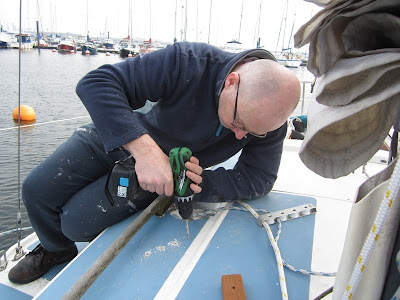What else? Oh yes, there's a list somewhere on the boat of things that we were going to do this winter. A trip to the chandlers, and a few purchases online and we'd better get started. This won't take long.......
Firstly, a new sea toilet. The inlet and outlet pipes were the same diameter, and in roughly the same position, and the toilet fittings were adjustable, so the angles should be straightforward......
So, it took a whole day, naturally. I fitted and removed the thing four times. After the first fitting, taking about an hour, I thought it was fine, apart from a tiny drip from the outlet hose. Toilet out, trim the hose, back in, still leaking. Eventually, Louise drove to the local chandlers and we renewed the entire length of outlet pipe - the old one had become inflexible. Once the new pipe was fitted, the toilet went in and no leaks. Works like a dream, and so much better.
Next, the taps in the heads and galley would be changed. The heads took about 15 minutes. The one in the galley took, er, a day. Remove the old tap, fill the hole, retile, make a teak plinth for the new tap, remove tiles in new position, drill, seal, etc, etc. I'm beginning to realise that thinking a job will take x amount of time on a boat is a waste of time. Don't estimate, it will take as long as it takes.
Next job, lead the control lines for the mainsail back to the cockpit - makes sail handling in rough weather easier, and a lot safer. I'd bought second hand winches last year, and we shelled out for the clutches, deck organisers and a nice piece of teak to cut and mount everything on. £91 for a length of teak 1.2m long, 150mm wide and 32mm thick. Ouch!
Two days? Nope. Three weeks. Lining everything up, ordering bolts to go through the saloon roof, testing, realigning, ordering new bolts, cutting drilling
Taking down the headlining, only to find it had been glued up, and removing it destroyed it, yet more work, buying new plywood and material to cover it....
Every day, it seemed the boat was in more of a mess. Would we ever get it done? Meanwhile, Louise had decided to redo all of the seating. She'd bought some 7cm thick memory foam mattresses and, cut and glued them onto the original foam, doubling the thickness and infinitely increasing the comfort factor. Then she remade each cover, one at a time, over weeks, and did a beautiful job.
The first trip of the year was approaching, a late March overnight stay up at Portishead. Time was getting short, but finally, a few days before we were due to go, everything came together.
On a beautiful spring evening, we took Ishtar out into the bay - our first sail for months. I was dreading trying to hoist the sails, in case all of my work had come to nought, and everything jammed.
Mainsail up. Easy. Try reefing. Unbelievable. I'd led back a reefing line from the Leech (back) and the Luff (front) of the sail. Shortening sail simple meant letting out one line whilst pulling in on two others. I was delighted with the way it all worked.
Louise's hard work had paid off too. The new seating looked great and was extremely comfortable. Many people have said to us that owning a boat is about constant maintenance and DIY, and the time spent enjoying it is far less than the time spent working on it. At times, it seems this way to us, too.























